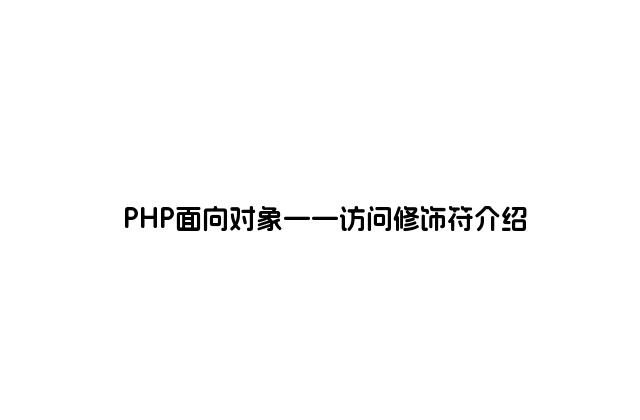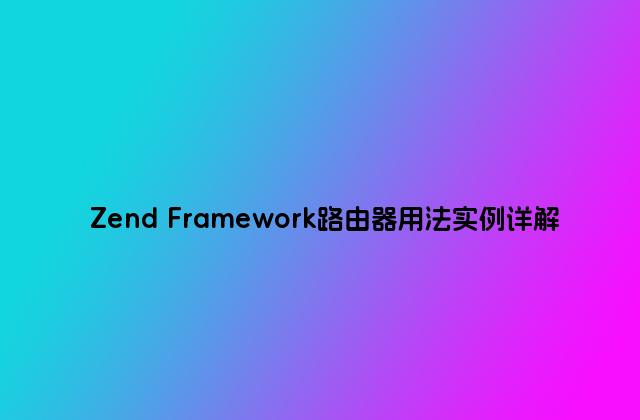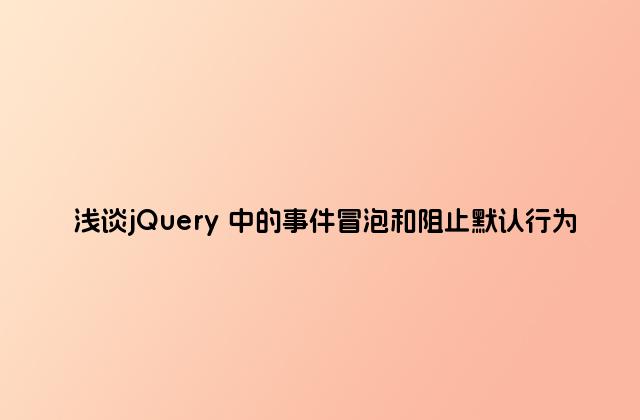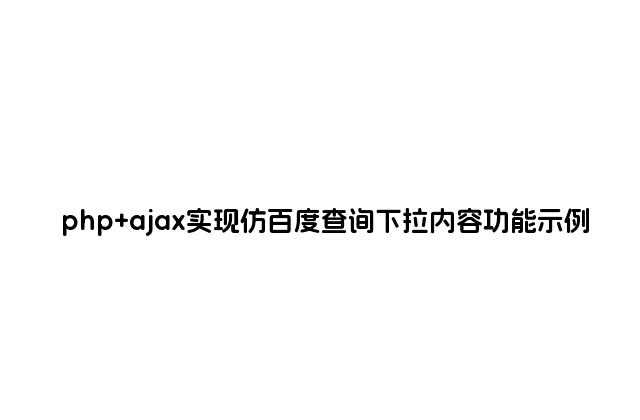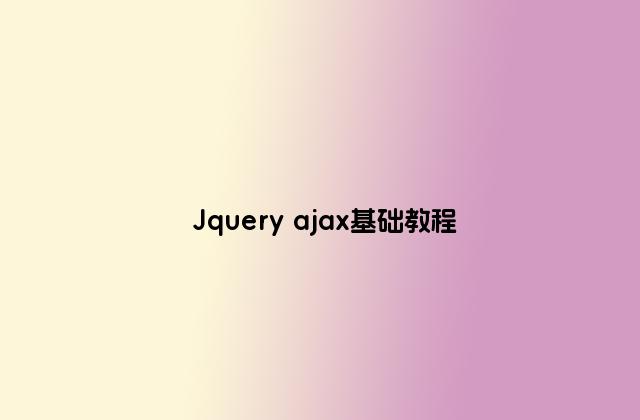
jQuery的Ajax帶來(lái)了無(wú)需刷新的web頁(yè)面革命。這里就詳細(xì)介紹一下jQuery所涉及到的Ajax操作。(無(wú)需特殊說(shuō)明,均需要有服務(wù)器配置,這里本人用的是Tomcat 7)
1.基于請(qǐng)求加載文件數(shù)據(jù)
這里的請(qǐng)求通常都是網(wǎng)頁(yè)的某些操作,如點(diǎn)擊等。
而其加載數(shù)據(jù)的類型歸類為以下四種:a.加載HTML文件;b.加載JSON文件;c.加載Javascript文件;d.加載XML文件。
其對(duì)應(yīng)的四種加載方法分別是:load、getJSON、getScript、get。
a.加載HTML文件
把編寫(xiě)好的HTML文件加載到網(wǎng)頁(yè)中。例如:
//load方法加載html文件
$('#letter-a a').click(function(){
$('#dictionary').load('a.html');
return false;
});
這里a.html也是放在服務(wù)器端的一個(gè)已經(jīng)編寫(xiě)好的頁(yè)面文件,直接調(diào)用load,就可以讓所匹配的目標(biāo)內(nèi)載入HTML內(nèi)容。
b.加載JSON文件
把編寫(xiě)好的JSON文件加載到網(wǎng)頁(yè)中。例如:
//加載json文件
$('#letter-b a').click(function(){
$.getJSON('b.json',function(data){
var html = '';
$.each(data,function(entryIndex, entry){
html += "<div class='entry'>";
html += "<h3 class='term'>" + entry.term + "</h3>";
html += "<div class='part'>" + entry.part + "</div>";
html += "<div class='definition'>";
html += entry.definition;
if(entry.quote){
html += '<div class="quote">';
$.each(entry.quote, function(lineIndex, line){
html += '<div class="quote-line">' + line + '</div>';
});
if(entry.author){
html += '<div class="quote-author">' + entry.author + '</div>';
}
}
html += "</div>";
html += "</div>";
});
$('#dictionary').html(html);
});
return false;
});
getJSON方法第一個(gè)參數(shù)是指加載的文件路徑,第二個(gè)參數(shù)是一個(gè)加載完成以后的回調(diào)函數(shù)。通過(guò)這個(gè)回調(diào)函數(shù),就可以對(duì)加載好的data進(jìn)行操作。重復(fù)的部分使用each循環(huán)處理。最后將拼湊好的html字符串使用html方法加入到目標(biāo)id=dictionary的元素中。
c.加載Javascript文件
加載Javascript文件和加載HTML文件類似。這里需要注意的是,使用getScript方法加載進(jìn)來(lái)的Javascript會(huì)根據(jù)當(dāng)下Javascript環(huán)境直接運(yùn)行。例如:
//執(zhí)行腳本
$('#letter-c a').click(function(){
$.getScript('c.js');
return false;
});
d.加載XML文件
jQuery中可以使用get方法加載XML文件。例如:
//加載XML文檔
$('#letter-d a').click(function(){
$.get('d.xml',function(data){
$('#dictionary').empty();
$(data).find('entry').each(function(){
var $entry = $(this);
var html = '<div class="entry">';
html += '<h3 class="term">' + $entry.attr('term') + '</h3>';
html += '<div class="part">' + $entry.attr('part') + '</div>';
html += '<div class="definition">';
html += $entry.find('definition').text();
var $quote = $entry.find('quote');
if($quote.length)
{
html += '<div class="quote">';
$quote.find('line').each(function(){
html += '<div class="quote-line">';
html += $(this).text() + '</div>';
});
if($quote.attr('author')){
html += '<div class="quote-author">';
html += $quote.attr('author') + '</div>';
}
html += '</div>';
}
html += '</div>';
html += '</div>';
$('#dictionary').append($(html));
});
});
return false;
});
XML文件有一個(gè)特點(diǎn)就是,你可以像用jQuery操作HTML那樣操作XML的那些元素。如使用attr方法、text方法等等。
2.基于Get方法向服務(wù)器獲取數(shù)據(jù)
之前的例子都是從服務(wù)器上靜態(tài)的獲取數(shù)據(jù)文件。而Ajax的價(jià)值不只于此,通過(guò)get方法從服務(wù)器動(dòng)態(tài)的獲取數(shù)據(jù),為web頁(yè)面無(wú)刷新的實(shí)現(xiàn)提供了莫大的幫助。
下面就使用get方法從服務(wù)器獲取一段所需要的數(shù)據(jù)。這里,本人結(jié)合J2EE的Struts2框架和TOMCAT搭建的服務(wù)器端。具體服務(wù)器端多種多樣,可以是php+apache或者其他什么的都可以。
操作如下,用戶點(diǎn)擊Eavesdrop則發(fā)送get方法到服務(wù)器,取得Eavesdrop的數(shù)據(jù),并且返回json值,然后在jQuery中裝配。
代碼如下:
//GET方法加載服務(wù)器內(nèi)容
$('#letter-e a').click(function(){
var requestData = {term:$(this).text().toUpperCase()};
$.get('EGet.action', requestData, function(data){
//返回的數(shù)據(jù)包結(jié)構(gòu)根據(jù)Struts2配置如下:
//{"resultMSG":"{ 內(nèi)部另一個(gè)json結(jié)構(gòu) }","success":"true"}
//先將返回的數(shù)據(jù)包拆包
var responseObj = eval("("+data+")");
if(responseObj.success == 'true')
{
$('#dictionary').empty();
//返回成功,接下來(lái)再次解包resultMSG
var dataObj = eval("("+responseObj.resultMSG+")");
var html = "";
html += "<div class='entry'>";
html += "<h3 class='term'>" + dataObj.term + "</h3>";
html += "<div class='part'>" + dataObj.part + "</div>";
html += "<div class='definition'>";
html += dataObj.definition;
if(dataObj.quote){
html += '<div class="quote">';
$.each(dataObj.quote, function(lineIndex, line){
html += '<div class="quote-line">' + line + '</div>';
});
if(dataObj.author){
html += '<div class="quote-author">' + dataObj.author + '</div>';
}
}
html += "</div>";
html += "</div>";
$('#dictionary').html(html);
}
else
{
var $warning = $('<div>Sorry, your term was not found!</div>');
$('#dictionary').html($warning);
}
});
return false;
});
這里要說(shuō)明的是由于struts2配置,返回的時(shí)候在需要的數(shù)據(jù)外又打了一層包,用于表示結(jié)果內(nèi)容的resultMSG和是否ajax訪問(wèn)成功的success字段。所以使用了2次eval解包。
這里我后臺(tái)java程序傳遞過(guò)來(lái)的并非配置好的HTML,而是僅僅是json類型的數(shù)據(jù),本人認(rèn)為在java層面編寫(xiě)html并傳遞不如直接傳遞數(shù)據(jù)方便,以后修改樣式或者頁(yè)面結(jié)構(gòu)也都不如直接修改javascript方便。
通過(guò)get方法獲得服務(wù)器數(shù)據(jù),相當(dāng)于向服務(wù)器提交如下這種請(qǐng)求:EGet.action?term=XXX
下面放出java后臺(tái)文件代碼:
1.EGet.java
package lhb;
import com.opensymphony.xwork2.ActionSupport;
public class EGet extends ActionSupport
{
private String term;
private Terms sampleTerm;
private String success;
private String resultMSG;
/**
*
*/
private static final long serialVersionUID = 1L;
public String execute() throws Exception
{
initData();
if(term.equals(sampleTerm.getTerm()))
{
success = "true";
resultMSG = "{"term": ""+sampleTerm.getTerm()+"","+
""part": ""+sampleTerm.getPart()+"","+
""definition": ""+sampleTerm.getDefinition()+"","+
""quote": ["+
""Is public worship, then, a sin,","+
""That for devotions paid to Bacchus","+
""The lictors dare to run us in,","+
""And resolutely thump and whack us?""+
"],"+
""author": ""+sampleTerm.getAuthor()+""}";
}
else{
success = "false";
resultMSG = "fail";
}
return SUCCESS;
}
//初始化數(shù)據(jù)
private void initData()
{
String partEAVESDROP = "v.i.";
String definitionEAVESDROP = "Secretly to overhear a catalogue of the crimes and vices of another or yourself.";
String quoteEAVESDROP[] = {"A lady with one of her ears applied",
"To an open keyhole heard, inside,",
"Two female gossips in converse free —",
"The subject engaging them was she.",
""I think," said one, "and my husband thinks",
"That she's a prying, inquisitive minx!"",
"As soon as no more of it she could hear",
"The lady, indignant, removed her ear.",
""I will not stay," she said, with a pout,",
""To hear my character lied about!""};
String authorEAVESDROP = "Gopete Sherany";
Terms EAVESDROP = new Terms();
EAVESDROP.setTerm("EAVESDROP");
EAVESDROP.setPart(partEAVESDROP);
EAVESDROP.setDefinition(definitionEAVESDROP);
EAVESDROP.setQuote(quoteEAVESDROP);
EAVESDROP.setAuthor(authorEAVESDROP);
sampleTerm = EAVESDROP;
}
public String getTerm()
{
return term;
}
public void setTerm(String term)
{
this.term = term;
}
public String getSuccess()
{
return success;
}
public void setSuccess(String success)
{
this.success = success;
}
public String getResultMSG()
{
return resultMSG;
}
public void setResultMSG(String resultMSG)
{
this.resultMSG = resultMSG;
}
}
這個(gè)action中的數(shù)據(jù)本人直接配置了,這里只是做一個(gè)示范使用。真正的這些數(shù)據(jù)在項(xiàng)目中一般是存放在數(shù)據(jù)庫(kù)中的。由于這主要是jQuery方面的小示例,就不弄那么麻煩了。
2.Terms.java
package lhb;
public class Terms
{
private String term;
private String part;
private String definition;
private String quote[];
private String author;
public String getTerm()
{
return term;
}
public void setTerm(String term)
{
this.term = term;
}
public String getPart()
{
return part;
}
public void setPart(String part)
{
this.part = part;
}
public String getDefinition()
{
return definition;
}
public void setDefinition(String definition)
{
this.definition = definition;
}
public String[] getQuote()
{
return quote;
}
public void setQuote(String[] quote)
{
this.quote = quote;
}
public String getAuthor()
{
return author;
}
public void setAuthor(String author)
{
this.author = author;
}
}
這個(gè)類純粹就是一個(gè)pojo類。沒(méi)有什么特別的方法。
3.struts.xml
這個(gè)是struts2的json方式傳遞配置
<?xml version="1.0" encoding="UTF-8"?>
<!DOCTYPE struts PUBLIC
"-//Apache Software Foundation//DTD Struts Configuration 2.3//EN"
"http://struts.apache.org/dtds/struts-2.3.dtd">
<struts>
< 指定全局國(guó)際化資源文件 -->
<constant name="struts.custom.i18n.resources" value="i18n"/>
< 指定國(guó)際化編碼所使用的字符集 -->
<constant name="struts.i18n.encoding" value="GBK"/>
< JSON的action -->
<package name="jsonInfo" extends="json-default">
<action name="EGet" class="lhb.EGet">
<result type="json">
<param name="contentType">text/html</param>
<param name="includeProperties">success, resultMSG</param>
</result>
</action>
</package>
</struts>
這里可以看到includeProperties里所配置的外面一層json,success和resultMSG。這在實(shí)際中很好用。如果服務(wù)器中沒(méi)有取得需要的值,雖然ajax訪問(wèn)成功,但是獲得的結(jié)果并不算成功,因?yàn)闆](méi)有取得需要的值。這里加入了success標(biāo)示,方便前臺(tái)jQuery操作。
基于其他方法獲取服務(wù)器數(shù)據(jù)從寫(xiě)法上與get基本一致,如post方法、load方法。這里就不再贅述了。
3.動(dòng)態(tài)提交表單
通過(guò)jQuery的AJAX支持,可以讓我們很方便的動(dòng)態(tài)提交表單而不用刷新頁(yè)面。
如下面例子:
$('#letter-f form').submit(function(){
//調(diào)用preventDefault方法阻止事件冒泡,具體工作就是如果網(wǎng)頁(yè)有腳本錯(cuò)誤,那么則會(huì)阻止提交form表單
event.preventDefault();
var formValues = $('input[id="term"]').val();
var requestStr = {'term':formValues.toUpperCase()};
$.get('EGet.action', requestStr, function(data){
var responseObj = $.parseJSON(data);
if(responseObj.success == 'true')
{
var html = '';
var dataObj = $.parseJSON(responseObj.resultMSG);
html += "<div class='entry'>";
html += "<h3 class='term'>" + dataObj.term + "</h3>";
html += "<div class='part'>" + dataObj.part + "</div>";
html += "<div class='definition'>";
html += dataObj.definition;
if(dataObj.quote){
html += '<div class="quote">';
$.each(dataObj.quote, function(lineIndex, line){
html += '<div class="quote-line">' + line + '</div>';
});
if(dataObj.author){
html += '<div class="quote-author">' + dataObj.author + '</div>';
}
}
html += "</div>";
html += "</div>";
$('#dictionary').html(html);
}
else{
var warning = $('Sorry, your term was not found!');
$('#dictionary').html(warning);
}
});
});
這個(gè)例子援引的數(shù)據(jù)還是上一個(gè)EGet.action所用的那個(gè)數(shù)據(jù)。程序的操作過(guò)程基本是:
首先調(diào)用這個(gè) preventDefault();這個(gè)方法在注釋里也說(shuō)明了,用于阻止事件冒泡帶來(lái)的不便與麻煩。
接下來(lái)通過(guò)$()獲得input的元素,使用val方法獲得其值,接下來(lái)的使用方法與上例基本相同。
這里也可以使用serialize方法將input元素序列化成如下格式“term=xxx”這樣。不過(guò)由于服務(wù)器端的java程序中的那些數(shù)據(jù)時(shí)硬編碼的,所有,不是太方便用,就沒(méi)用。
4.關(guān)于Ajax的觀察員函數(shù)
jQuery包含了2個(gè)全局的ajax觀察員函數(shù):ajaxStart和ajaxStop。
分別在執(zhí)行ajax操作的起始和結(jié)束時(shí)調(diào)用。例如:
//ajax的觀察員函數(shù) ajaxStart 和 ajaxStop
$('<div id="loading">Loading...</div>').insertBefore('#dictionary')
.ajaxStart(function(){
$(this).show();
}).ajaxStop(function(){
$(this).hide();
});
這里無(wú)論哪個(gè)a標(biāo)簽觸發(fā)ajax操作,包括靜態(tài)載入文件和動(dòng)態(tài)服務(wù)器訪問(wèn),都會(huì)觸發(fā)ajaxStart和ajaxStop。
關(guān)于錯(cuò)誤處理,常用的三個(gè)函數(shù):success、complete、error。
下面以error為例:
.error(function(jqXHR){
$('#dictionary').html('An Error occurred:'+ jqXHR.status).append(jqXHR.responseText);
});
可以以連綴的寫(xiě)法將error方法放置于get方法之后:“$.get().error()”這樣。
剛才看了一下,這個(gè)可以將Tomcat的報(bào)錯(cuò),加載到頁(yè)面之上。這在有的時(shí)候還是很有用的。如圖:
不過(guò)不知道為何這個(gè)將我原有樣式也覆蓋了一些,如果有哪位網(wǎng)友知道,麻煩指正一下問(wèn)題所在。謝謝了。
5.Ajax和事件
Ajax動(dòng)態(tài)訪問(wèn)服務(wù)器以后生成的元素,如果想綁定事件的話,一種方法是每次取到都重新綁定處理程序,這種相對(duì)來(lái)說(shuō)比較簡(jiǎn)單,但是不適合DOM結(jié)構(gòu)經(jīng)常變化的場(chǎng)景。如果DOM結(jié)構(gòu)經(jīng)常變化,那么就需要用live方法,實(shí)現(xiàn)事件委托。
live用法與bind一樣。
關(guān)于jquery ajax基礎(chǔ)教程今天小編就給大家介紹到這里,后續(xù)還會(huì)持續(xù)給大家介紹,希望大家繼續(xù)關(guān)注綠夏網(wǎng)網(wǎng)站,有你們的關(guān)注我們會(huì)做的更好,謝謝!

